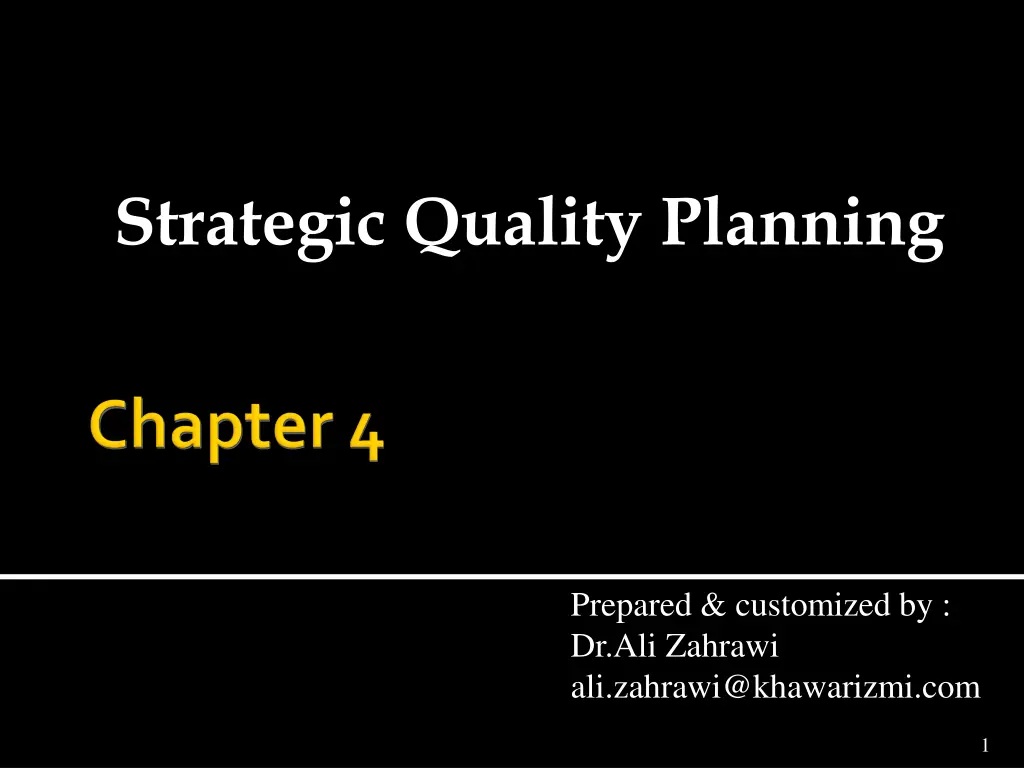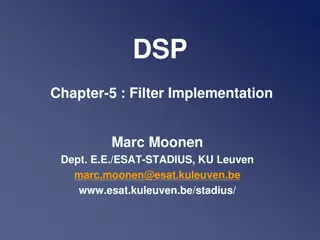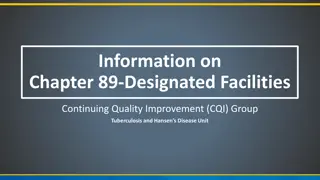
Strategic Quality Planning and Leadership Insights
Explore the significance of strategic quality planning, time management in quality improvement, and the essence of leadership in achieving super-ordinate goals. Dr. Ali Zahrawi shares valuable insights on strategy content, process, and the importance of time in quality improvement.
Download Presentation

Please find below an Image/Link to download the presentation.
The content on the website is provided AS IS for your information and personal use only. It may not be sold, licensed, or shared on other websites without obtaining consent from the author. If you encounter any issues during the download, it is possible that the publisher has removed the file from their server.
You are allowed to download the files provided on this website for personal or commercial use, subject to the condition that they are used lawfully. All files are the property of their respective owners.
The content on the website is provided AS IS for your information and personal use only. It may not be sold, licensed, or shared on other websites without obtaining consent from the author.
E N D
Presentation Transcript
Strategic Quality Planning Prepared & customized by : Dr.Ali Zahrawi ali.zahrawi@khawarizmi.com 1
Strategy Planning Strategic planning has two important dimensions. These are content and process. Strategic content answers the question of what is to be contained in the strategic plan. Strategic content refers to the variables, definitions, components, and concepts that are included in the strategy. Strategic process consists of the steps used to develop the strategy within an organization. Chapter 4-- Strategic Quality Planning 2
Strategy Content Why is Quality Planning Important? Strategy Content Variables: Quality improvement is a planned managerial Time activity. Leadership, Generic strategies, Quality improvement involves Quality as a core competency. identifying potential improvements. prioritizing potential areas for improvement. planning the implementation of projects and improvements. Chapter 4-- Strategic Quality Planning 3
The Importance of Time in Quality Improvement Two Important Aspects of Time The time taken to achieve business goals as a result of quality. The speed at which companies improve. Chapter 4-- Strategic Quality Planning 4
The Importance of Time in Quality Improvement (Contd..) Real-life experience shows that time is a key variable in improving quality. A review of many studies and writings suggests that time is an important variable to consider when managing successful quality improvement. Time is also an important component of strategy. Thus, strategic planning is important for continuous quality improvement. Chapter 4-- Strategic Quality Planning 5
The Importance of Time in Quality Improvement (Contd..) One of the approaches that some managers use we will call the management by dictate model. Using management by dictate, we set numeric goals for the coming year. Chapter 4-- Strategic Quality Planning 6
Leadership For Quality Leadership Leadership is the process by which a leader influences a group to move toward the attainment of super-ordinate goals. Super-ordinate goals are those goals that pertain to achieving a higher end that benefits not just the individual, but the group. Leadership is about the sharing of power. This power takes many forms. Chapter 4-- Strategic Quality Planning 7
Leadership For Quality (Contd..) Types of Power Power of Expertise Reward Power If a leader has rewards that he or she can bestow on subordinates in return for some desirable position, the leader has reward power. Sometimes a leader has special knowledge (or is perceived to have special knowledge). Coercive Power Referent Power If a leader is charismatic or charming and is followed because he or she is liked, then the leader has referent power. If the leader has power to punish the follower for not following rules or guidelines, the leader has coercive power. Chapter 4-- Strategic Quality Planning 8
Leadership For Quality (Contd..) Types of Power Leadership Dimensions 1. Trait dimension Leadership characteristics tied to the personal traits of leaders (such as height and intelligence). Legitimate Power Legitimate power comes with the position. 2. Leader skills Attributes such as knowledge, communication, planning, and vision. 3. Leader behavior This approach leaders behave to identify specific leadership styles and the effects of leadership style on subordinate performance. discusses how Chapter 4-- Strategic Quality Planning 9
Quality as Strategy Although quality can still win orders in some market, in many markets quality has become an order qualifier. This means that high-quality production is an essential ingredient to participation in the market. Quality is still an effective tool in successful exporting in the international market. We discuss quality as a strategy from the perspective of generic strategies. These generic strategies are cost, differentiation, and focus. Chapter 4-- Strategic Quality Planning 10
Quality as Strategy 1. Costs of Quality New definitions of cost are wide, considering the summation of costs over the life of a product. This includes service, maintenance, and operating costs for products There are two broad categories of costs: a) costs due to poor quality and b) costs associated with improving quality. PAF Paradigm : is a quality cost strategy Chapter 4-- Strategic Quality Planning 11
Quality as Strategy(contd..) PAF Paradigm Prevention costs are those costs associated with preventing defects and imperfections from occurring. Prevention costs include costs such as training , quality planning, process engineering, and other costs associated with assuring quality beforehand . Appraisal costs are associated with the direct costs of measuring quality. These can include a variety of activities such as lab testing, inspection, test equipment and materials, losses because of destructive tests, and costs associated with assessments for ISO 9000 or other awards. Chapter 4-- Strategic Quality Planning 12
Quality as Strategy(contd..) PAF Paradigm (continued) Failure costs are roughly categorized into two areas of costs. Internal failure costs are those associated with on-line failure. External failure costs are associated with product failure after the production process. This includes failure after the customer takes possession of the products (see Table ). Chapter 4-- Strategic Quality Planning 13
Examples of Failure Cost Chapter 4-- Strategic Quality Planning 14
Quality as Strategy(contd..) 2. Differentiation Through Quality Differentiation is achieved by a competitor if the customer perceives the product or service to be unique in an important way It is increasingly difficult to differentiate products based on quality alone. Chapter 4-- Strategic Quality Planning 15
Quality as Strategy(contd..) 3. Quality Through Focus Think of a product that is particularly regional or is marked to a particular group. That limited region or group is the object of the focus strategy. Such a focus strategy can be very profitable. Chapter 4-- Strategic Quality Planning 16
Quality as Strategy(contd..) Quality as a Core Competency Communication, involvement, and a deep commitment to working across organizational boundaries. It involves many levels of people and all functions. Core competencies do not diminish with use. Competencies are enhanced as they are applied and shared. Quality, in and of itself, is probably not a core competency. However, core competency is built on the foundation of a long-term commitment to quality and continual process improvement. Chapter 4-- Strategic Quality Planning 17






















